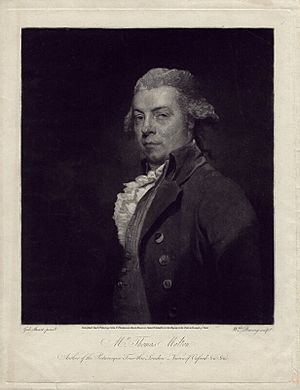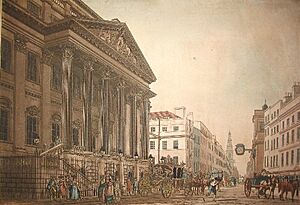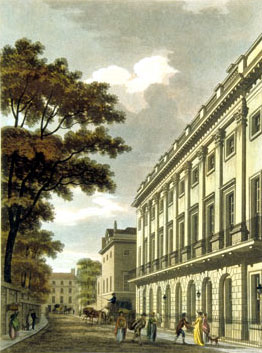Thomas Malton facts for kids
Quick facts for kids
Thomas Malton
|
|
|---|---|

1806 print by William Whiston Barney, after a portrait by Gilbert Stuart
|
|
| Born | 1748 |
| Died | 7 March 1804 |
| Occupation | Printmaker |
| Parent(s) | |
| Family | James Malton |
Thomas Malton (1748 – 7 March 1804), also known as Thomas Malton the Younger, was an English artist. He was famous for his detailed paintings and prints of cities and buildings. He was also an engraver, which means he made pictures by carving designs into metal plates.
Some very famous artists, like J. M. W. Turner and Thomas Girtin, learned from him. He is called "the Younger" to tell him apart from his father, who was also named Thomas Malton.
Life and Artistic Journey
Thomas Malton was born in London in 1748. His father, Thomas Malton the Elder, was also an artist. He was known for drawing buildings and writing about geometry, which is the study of shapes and spaces.
Early Career and Awards
Young Thomas Malton worked for three years in the office of James Gandon, a famous architect. In 1774, he won an award from the Society of Arts. He also studied at the Royal Academy. In 1782, he won a gold medal for his design of a theatre.
From 1773, he regularly showed his artwork at the Royal Academy. Most of his art showed London streets and buildings. He drew them using Indian ink and then added color. His drawings were very accurate, showing every detail of the buildings. This makes them very important for understanding what London looked like back then. He often added small groups of people to his scenes. It is thought that another artist, Francis Wheatley, helped him with these figures.
Teaching Famous Artists
Thomas Malton lived in London for most of his life. For a short time in 1780, he lived in Bath. From 1783 to 1789, he taught drawing classes in London. During this time, he had two very important students: Thomas Girtin and a young J. M. W. Turner. Turner's father brought him to Malton to learn about perspective, which is how artists create the illusion of depth on a flat surface.
Later in life, Turner said that Thomas Malton was his "real master." This shows how much he respected Malton's teaching.
Published Works and Legacy
Malton was one of the first artists to use a new printing method called aquatint. This method allowed him to make many copies of his detailed views. He used it to create large prints of buildings in London and Bath. He also painted some scenes for the Covent Garden Theatre.
In 1792, Malton published his most famous work. It was called A Picturesque Tour through the Cities of London and Westminster. This book had 100 aquatint pictures. Between 1798 and 1800, he created a similar series of pictures called Views from Cambridge. When he passed away, he was working on a series of views of Oxford. Some of these were published in 1802, and more were released in 1810.
An American artist named Gilbert Stuart painted a portrait of Thomas Malton the Younger. Malton passed away in London on March 7, 1804. He left behind his wife and six children.
Family Connections
Thomas Malton the Younger had a brother named James Malton (1761–1803). James was also a talented artist, draughtsman, and engraver. He worked in both Ireland and London.
Where to See His Art
You can find artworks by Thomas Malton in several places. These include the UK Government art collection and the Victoria and Albert Museum in London. His art is also at the Victoria Art Gallery in Bath, England. You can even see his work at the State Hermitage Museum in Saint Petersburg, Russia.
Images for kids








